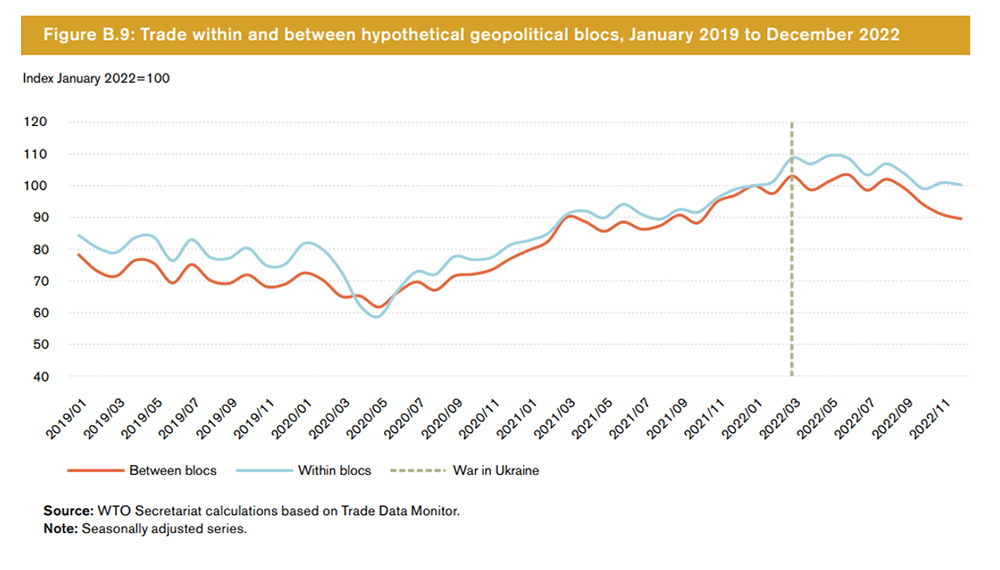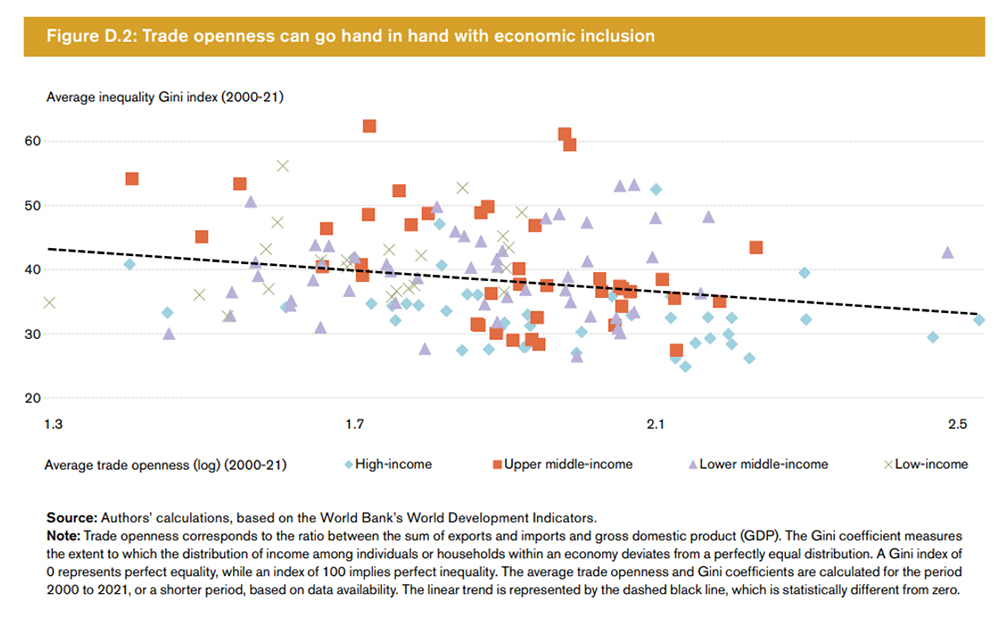Re-globalization for a secure, inclusive and sustainable future
What is the role of international trade in building a more secure, inclusive and sustainable world? This is the question asked by the 2023 World Trade Report published by the WTO today (12 September).
This question lies at the core of a contentious debate about the future of globalization, which has potentially far-reaching consequences for the future of the WTO. While it is widely acknowledged that international trade yields substantial efficiency gains, it is increasingly argued that some of these gains need to be sacrificed in favour of more important policy goals, notably maintaining peace and security, reducing poverty and inequality, and achieving a sustainable economy. This is a fundamental departure from the trade-affirming narrative that has guided trade policymaking since the foundation of the multilateral trading system in 1947.
This new narrative has gained traction amidst a series of crises and tectonic shifts in the balance of economic power. Intensifying geopolitical tensions have raised concerns about the weaponization of international trade. The COVID-19 pandemic has highlighted the importance of resilient supply chains. The rise of China has put pressure on workers in some industrialized countries and slowed down export growth in certain emerging economies. And the climate crisis has fueled doubts whether international trade is compatible with the need to decarbonize the economy.
The Report starts by showing that this change in narrative matters. While trade continues to thrive in many ways, trade tensions are rising, and the first signs of fragmentation are emerging.
Perhaps the most striking finding of this part of the Report is that trade is gradually becoming reoriented along geopolitical lines. This is illustrated in Figure B.9 of the Report, which plots trade within and between hypothetical geopolitical “blocs” constructed based on voting patterns in the UN General Assembly. Goods trade flows between these “blocs” have grown 4-6 per cent more slowly than within these blocs since the onset of the war in Ukraine, indicating a shift towards friend-shoring.

However, talk of de-globalization is still far from supported by the data. Bilateral trade between China and the United States reached a record high in 2022. Trade was remarkably resilient during the COVID-19 pandemic, bouncing back to pre-pandemic levels less than a year after the first wave of lockdowns. And trade in digitally delivered services has remained strong, growing at an average annual rate of 8.1 per cent between 2005 and 2022, outpacing goods (5.6 per cent) and other services (4.2 per cent).
The Report then turns to its main question, reviewing the evidence on the role of trade in building a more secure, inclusive and sustainable world. The main conclusion is that we need to embrace trade instead of rejecting it if we want to overcome the most pressing challenges of our time. In particular, the Report makes the case for extending trade integration to more economies, people and issues — a process that we call “re-globalization”.
This part of the Report begins with an analysis of the relationship between trade and security — understood broadly to include economic aspects, such as access to critical goods and resilience to shocks. A key conclusion is that a strong multilateral trading system is the best guarantor of economic security because it provides the options we need when faced with supply shortages. A case in point is the response of trade to the COVID-19 pandemic. In 2020, international supply chains became vital to ramping up production and distribution of medical supplies, with trade in medical goods rising by 16 per cent, trade in personal protective equipment rising by almost 50 per cent, and trade in face masks rising by 80 per cent.
At the same time, the Report stresses the need for expanding economic integration to more economies — a first example of re-globalization. As illustrated in Figure B.10 of the Report, the share of “bottleneck products,” defined as products that have few suppliers and large market shares, has more than doubled from 9 per cent to 19 per cent of all traded goods between 2000 and 2021.

The Report then turns to the relationship between trade and inclusiveness. It shows that trade integration is a powerful tool to improve living standards, which has helped lift hundreds of millions of people out of poverty. From 1981 to 2019, lower- and middle-income economies increased their share in global exports from 19 to 29 per cent and reduced the share of their population subsisting on less than US$ 2.15 per day from 55 per cent to 10 per cent.
It also acknowledges that import competition contributed to the loss of manufacturing jobs in countries like the United States. However, Figure D.2 of the Report shows that trade openness can go hand in hand with economic inclusion, suggesting that complementary domestic policies are key. For example, some of the most open economies, including Germany, Latvia and the Netherlands, are also some of the most equal ones.

Highlighted here is the need for re-globalization — including expanding economic integration to more people. For instance, African women would gain disproportionately from trade cost reductions in digitally delivered services, given that three out of four African firms trading exclusively through e-commerce are owned by women.
The Report finally looks at the relationship between trade and sustainability. While it acknowledges that the relationship is complex, it also makes clear that there is substantial scope for trade to be part of the solution to climate change. For example, trade provides access to technologies which are vital for the green transition. The import of high-quality wind turbines is a case in point, as they allow wind-rich countries to scale up their renewable energy generation even if they do not have the know-how to produce such turbines domestically.
This also provides a good illustration of the need to expand trade integration to more issues — and thus a third example of re-globalization. Trade is a powerful force multiplier for climate policies. Simulations show that more than one-third of the emission reductions achieved by a global carbon tax would be due to environmental gains from trade. Just as there are economic gains from trade from countries specializing in what they are relatively good at, there are also environmental gains from trade from countries specializing in what they are relatively green at. But this requires open trade coupled with coordinated climate action and in that sense an expansion of trade integration to more issues.
The Report also discusses the role of the WTO in fostering re-globalization. It underlines that WTO members have already made progress towards this goal in recent years. Examples include multilateral agreements like the Trade Facilitation Agreement and the Fisheries Subsidies Agreement as well as plurilateral outcomes on services domestic regulation and investment facilitation for development. To cite just one number, WTO estimates show that the Trade Facilitation Agreement has led to a US$ 231 billion increase in trade. Trade gains have particularly accrued to least-developed countries, the exports of which increased by 2.4 per cent, with a 17 per cent increase in the agriculture sector.
But to achieve a secure, inclusive and sustainable future, more needs to be done. The WTO Trade Cost Index shows that trade costs in middle- and low-income countries are 27 per cent higher than in high-income countries. Trade costs in services are 34 per cent higher than in manufacturing. And trade costs in agriculture are 46 per cent higher than in manufacturing. This points to trade-costs reductions for developing countries in agriculture and in services — including digitally delivered services - as natural priorities for the future.
